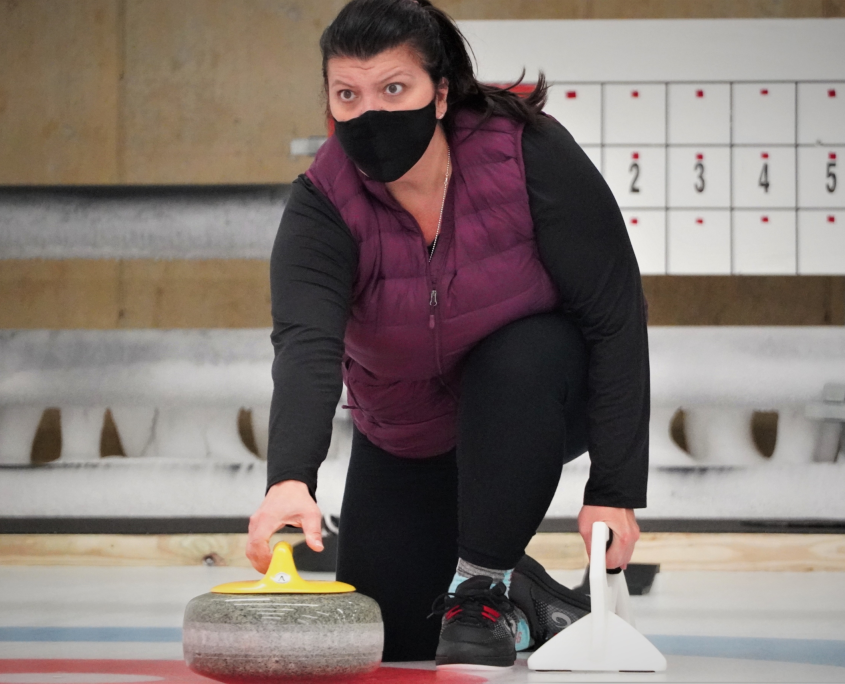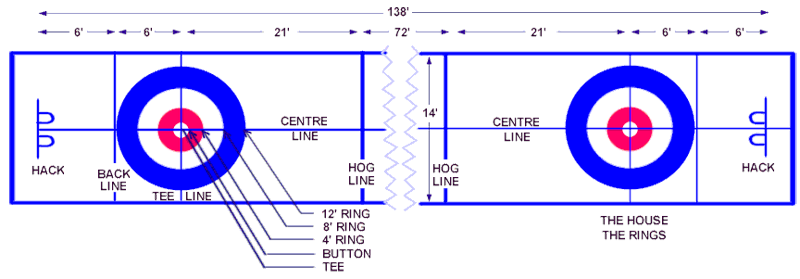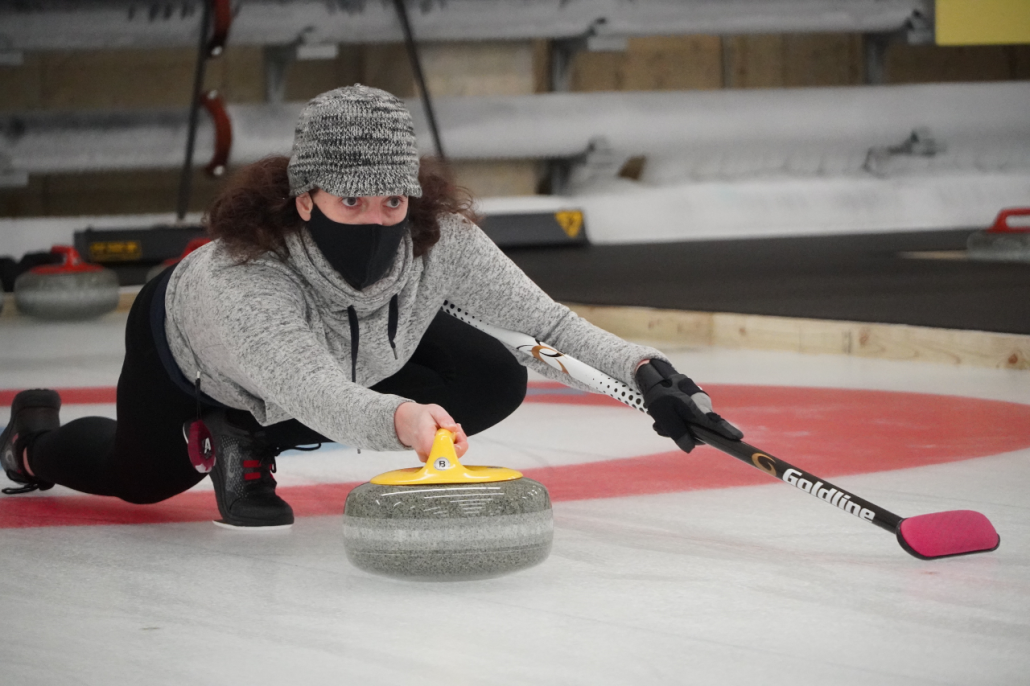Getting Started
See why it’s called “The Roaring Game”

From beginner to seasoned pro, everyone has to start somewhere– and that somewhere is a Learn 2 Curl class. We’re honored you want to try one of the greatest winter sports with us!
At Windy City Curling, we genuinely mean it when we say this sport is not “just curling, it’s community.” We pride ourselves on being open and accepting of anyone & everyone who wants to play at our club. When you register to Learn 2 Curl, you’re in for a great time with great people!
All of the basics you could want to know to start sliding rocks is taught in this class, and we run them throughout the year!
If you’re looking for a primer on the rules and the awesome fun you’re getting yourself into, read on…
History of Curling
Curling is a team sport played by two teams of four players on a rectangular sheet of ice. It is one of the world’s oldest team sports, having originated in 16th-century Scotland. The earliest games were played during winter on frozen ponds and lochs, with the earliest-known curling stones coming from the regions of Stirling and Perth. (These date from 1511!) It wasn’t until the 1600s that stones with handles were introduced.
Scotland’s Grand Caledonian Curling Club, formed in 1838, formulated the first official rules of curling. This club eventually became the Royal Caledonian Curling Club in 1843, and still exists today. Since the 1900s, stones have become standardized, the slide delivery was developed, and the indoor ice facilities became commonplace.

Etiquette
Click the headings to learn more! –>
Curling is a game of physical skill, mental accuity, and teamwork. In addition, our sport prides itself on maintaining high standards of sporting behavior. There are no on-ice officials during game play, so it is up to the players to be honest at all times. Rarely will you ever see a curler who does not call out their own foul while playing. Poor sports soon find themselves with a bad reputation and no teammates! This time-honored tradition is what allows players from all walks of life to enjoy a great game.
One of the most common infractions for new players is their broom touching the stone while sweeping. When this happens, the player who made contact will stop the stone before it impacts the field of play, let everyone know they “burned the rock,” and then remove it from play. Performing this simple action reflects well on your honor, and greatly increases how you are viewed by others (even though you may feel bad about the honest mistake).
Another example: complimenting a great shot, even if it’s from the other team! Everyone wants to win, but losing to a great shot is nothing to be ashamed about. Remember: we’re all curlers, curling is hard, and seeing a well-executed shot is awesome (even if it’s one made against your team).
- At the start of each game, all opponents and teammates shake hands and offer a genuine, “Good curling!”
- During the game, compliment good shots, never cheer for a missed one.
- No cell phones while playing.
- Arrange for a substitute to take your position if you cannot make it to a game.
- At the end of each game, all opponents and teammates shake hands and offer another genuine, “Good curling!”
- Broomstacking: All games end with a celebratory drink, regardless of the outcome.
- The winning team buys the first round (Skips buy Skips, Vices for Vices, etc.).
- If time allows, the losing team buys the next round.
The Basics
Curling is a challenging and fun sport where all ages, genders, and abilities can play on a competitive level. Each standard game of curling consists of eight “Ends” (or, round of play; think of it like an “inning” in baseball), and lasts about two hours. Two teams alternate turns delivering stones down a sheet of ice trying to get their rocks closest to the center of a target known as the “house.” Each team consists of four players: the Lead, the Second, the Vice, and the Skip. The Skips act as the captain of the team, calling all of the shots. Each player delivers two stones per End (eight stones per team, 16 stones in all).
The Ice
Curling is played on a “sheet” of ice approximately 150-feet long, and 15-and-a-half feet wide. The ice is prepared before each game by pebbling it with small droplets of water. This pebble creates small bumps of texture on the ice, and allows the stones to glide further than if there was no pebbling on it.
At either end of the sheet is a target known as the House. The center-most circle is called Button.
Behind each house are runners-blocks imbedded in the ice, called Hacks. These help the player delivering a stone a solid surface to push off of. Roughly 33-feet in front of the hack is the Hogline. Players sliding out must let go of the rock before it touches the Hogline closest to them, and their stone must travel completely over the Hogline furthest from them in order their shot to be valid, and remain in play. Any stone that touches the side of the sheet, or completely crosses the Back Line is immediately considered out-of-bounds, removed from the field of play, and put behind the hacks until needed for the next End.
The line running the length of the sheet from hack to hack down the middle is the “center line,” and serves as a visual guide for players. Where the center line crosses the dead-center of the House (aka – the “pin”), a perpendicular line is marked called the “Tee line.” The Tee line gets its name because it simply forms a ‘T’ in the middle of the house, and it also helps act a visual guide for players.
The area in front of the house, still in play, is known as the Free Guard Zone. Any stone stopping here is considered a Guard, and cannot be taken out by an opponent during the first five total rocks of any given End. If a guard is hit out by one of these stones, the original stone is put back to where it was before being hit (as best as the teams are able). Any stone touching the House in any way, however, is fair game for a “Take out.”


Equipment
The equipment used in curling is few, which makes the barrier of entry relatively low for new players. Windy City Curling keeps a stock of all of the equipment a beginner would need on-hand. This allows everyone to start playing immediately, without having to buy gear.

Step-on Sliders
Instead of curling shoes, most facilities, such as Windy City Curling, will provide a Teflon slider new players can step onto for when they slide out to deliver a stone. While these sliders offer a similar experience to shoes, they are often not as thick, nor as stable. This makes delivering rocks slightly more challenging, and makes finding that ever-elusive consistent delivery much harder to perfect.
Stabilizers
An alternative for players who might not be comfortable sliding out with their broom, stabilizers provide more surface-contact with the ice during a delivery. These are legal in all levels of play, and do not reflect on an athlete’s level of skill. Stabilizers come in all shapes, sizes, and colors (including molded plastic, wood, and PVC pipe).
Delivery Sticks
A delivery stick has with a specialized attachment at the end of it, so stones can be delivered and curled from an upright and/or stationary position (such as while standing, while walking, or from a wheelchair). This allows anyone with mobility issues who cannot slide to still enjoy the sport of curling alongside their family and friends.
Stones / Rocks
Curling stones are made from granite and weigh approximately 42 lbs. each. There is a handle located on the top of each stone which allows the player to grip it as well as rotate it while delivering it down the ice. The rotation is what allows the stone to “curl” once it begins to slow down. The bottom of each stone is concave, leaving a pocket of air between it and the ice with the exception of a slim ring approximately ¼ inch in thickness. Stones are always kept on the ice between games throughout the season to keep them at the proper temperature.
Brooms
Curlers will use brushes to “sweep” in front of the stone as their team delivers it towards the opposite house. The act of sweeping slightly scratches the ice and helps the stone travel further, with more or less curl (based on the direction the sweeper is brushing).
Shoes
Curling shoes have one sole with thick Teflon on it, allowing the player to slide down the ice while delivering a stone. They also come with a rubber gripper to go over the Teflon during all other times of the game, to give players a better grip while walking on the ice. Shoes are the one piece of gear generally not provided by curling clubs. That’s why they’re the first piece of equipment most places recommend buying.

Scoring
Scoring in curling often seems much harder than it actually is. Below we will give some examples on both how to calculate the score as well as marking it on a curling scoreboard.
Scoring in the house
Once both teams have delivered their eight stones each, that “end” is complete. Think of an “end” as an “inning” in baseball. The vices of both teams will tally scores for that end. One point is scored for the team with their stone closest to the center of the house which is also known as the “button.” The team who wins the end is also awarded one point for each of their stones that are resting in (or touching) the house that are also closer than their opponents closest stone to the button. The points awarded do not change based on what ring it is in our touching. The rings are there only to help judge placement. Below are a few examples of typical scoring situations curlers will see while playing.

High Profile Event Scoreboard (Olympics)
Now that you understand how to calculate scores, you need to mark them on the score board. When watching Olympic or other higher level events, the scoreboard will resemble that of other major sporting events like baseball. Here, each end shows how many points were scored and by what team. Those points are then totaled at the end.
In the example to the right, Yellow won the match 7-6. Although this is what you will generally see while watching on TV, it is not how curling traditionally scores a match. A couple things to take note of:
Ends are listed across the top like in baseball.
The hammer icon next to Red indicates that in the 7th end, Yellow scored so they will deliver first in the 8th end. Thus giving Red the hammer or last stone thrown in the 8th end.

Traditional Scoreboard
A traditional curling scoreboard is shown above. Notice how the teams on the top and bottom of the board with points being listed down the center.


